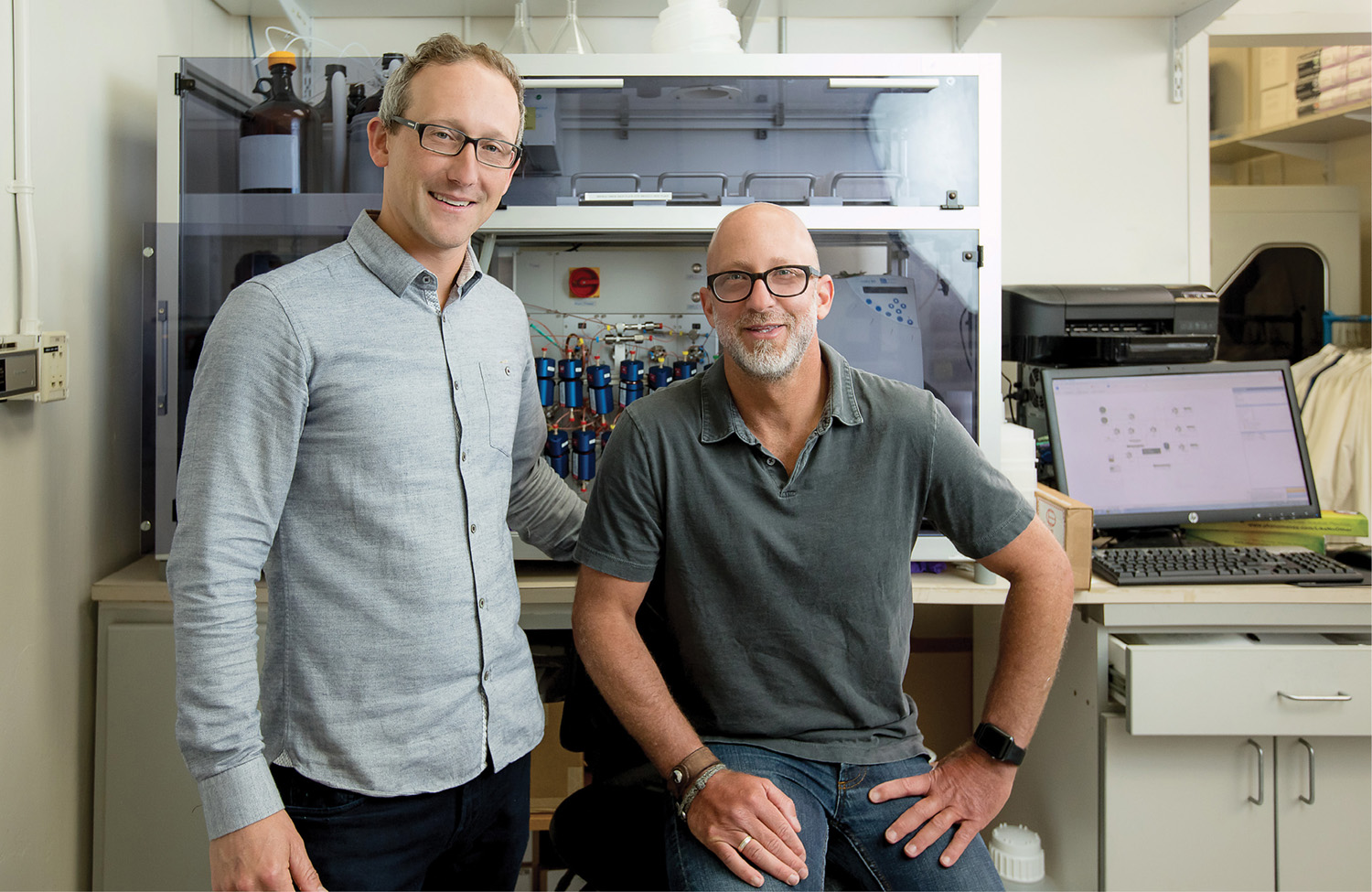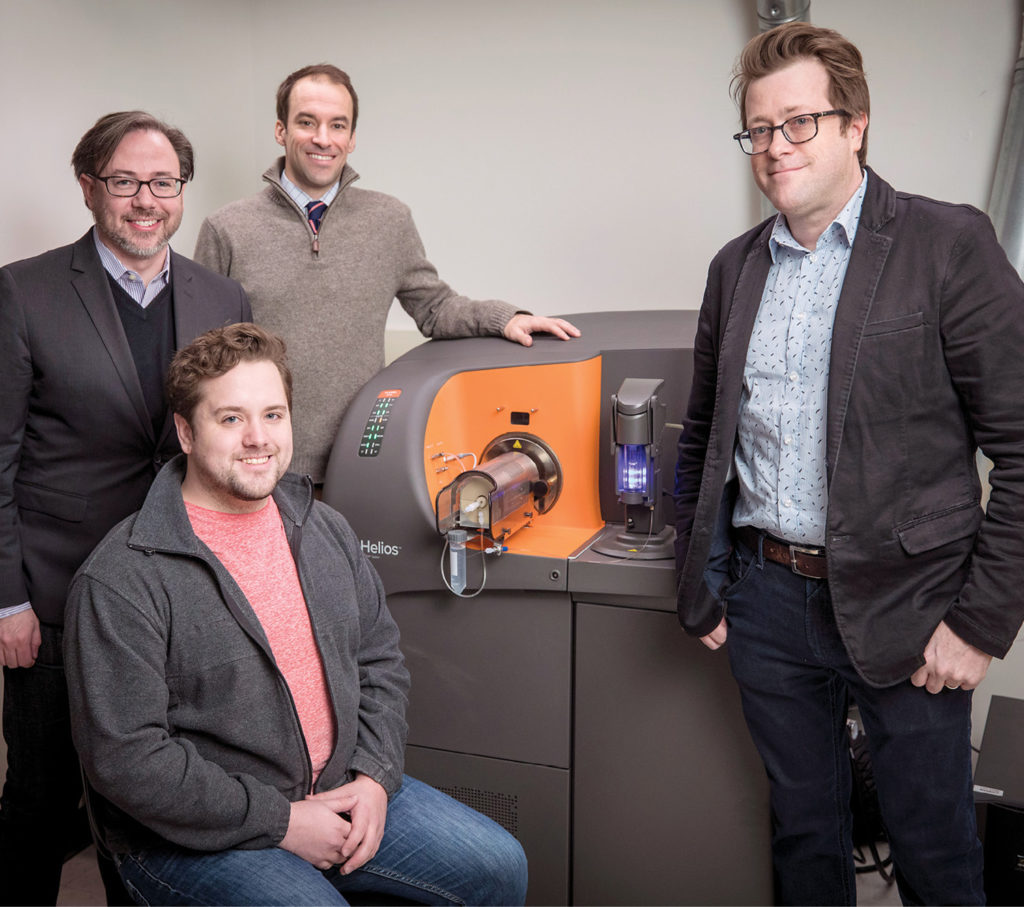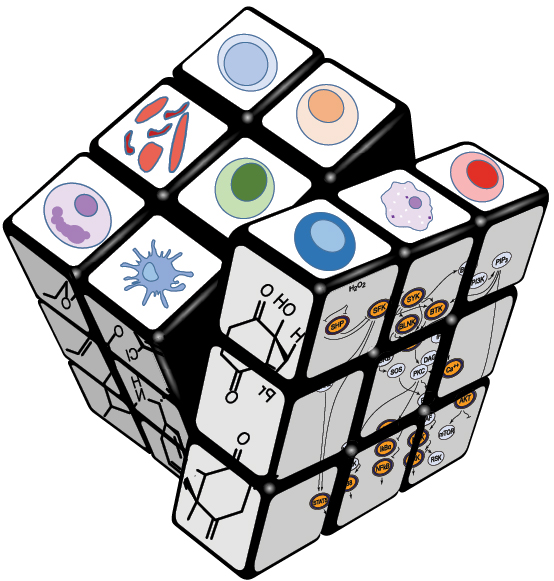
The diagnosis could’ve been devastating, had Eduardo Esquenazi let it be. He was just 28, leading an otherwise healthy and active life, when he learned that he had advanced testicular cancer. Surgery and two regimens of chemotherapy followed, but the discomfort, tedium and uncertainty of those months didn’t discourage him. If anything, they provided him some much-needed clarity.
“When I first got the diagnosis, there was a sense of relief. At least I knew what I was up against. I wasn’t frightened, but it definitely made me give some thought to my career,” says Esquenazi, BS’98, who at the time was earning his Ph.D. in neurobiology at the University of California, San Diego. “I realized I might not have much time left, so I asked myself, ‘Do I really want to continue what I’m doing?’”
The question, it turns out, was surprisingly easy to answer. Ever since he’d decided to major in neuroscience at Vanderbilt, Esquenazi had assumed he’d someday become a college professor, teaching and conducting research, but now he had misgivings about that choice. He tried visualizing himself in the academic setting he’d once striven toward but found he no longer could.
Instead he kept returning in his mind to the place that had fascinated him since his childhood in Colombia, the one place where he felt most alive: the ocean. The decision at hand was not unlike the ones he faced while bobbing in the water on his surfboard, patiently scanning the horizon for good waves. Experience had taught him which approaching swells to pass up and which to pursue. If he paid close enough attention, the ocean would let him know when to act.
And now, during the long hours of his treatment, that very thing was happening again. The ocean was speaking to him, not through the rise and fall of its waves, but rather through the monotonous drip-drip-drip of the cancer drugs he’d been prescribed.
“I realized something pretty profound,” he explained to an audience during a 2017 TEDx Talk at UC San Diego. “Most of the medications I was taking were derived from nature. I’ve been a scientist my whole life, but I didn’t know this. I was blown away.”
If, he thought, a powerful cancer drug like Taxol could be obtained from the bark of a Pacific yew tree, imagine what’s waiting to be discovered in the ocean, which covers nearly three-quarters of the earth’s surface but remains, by most estimates, 95 percent unexplored. Marine organisms possibly could provide the key to more effective drugs for cancers like his, as well as a range of other diseases.
And so, upon completing his treatment and being declared cancer-free in 2007, Esquenazi returned to UC San Diego—not to the neurobiology program this time, but rather to enroll in a doctoral program at its Scripps Institution of Oceanography. There he studied how to identify and isolate medically promising chemistry from marine organisms while earning his Ph.D. It was also where he began plans for the biotechnology company he would eventually found in 2011: Sirenas.
Today the San Diego-based company, which takes its name from the Spanish word for the sirens of sea lore, is applying trailblazing methods toward drug discovery. Using innovative data-mining technology, Esquenazi and his colleagues—including Sirenas CEO and fellow Vanderbilt alumnus Jake Beverage, BA’98—have identified several promising small-molecule drug candidates.
Their success has resulted in two research grants totaling $1.68 million from the Bill & Melinda Gates Foundation to generate new leads for treating neglected diseases, such as tuberculosis and malaria. Sirenas also has signed a research collaboration agreement with Bristol-Myers Squibb to identify potential drug candidates for the biopharmaceutical company.
“I was pretty naïve when I started Sirenas,” says Esquenazi, who now serves as the company’s chairman and head of innovation. “And in some ways I still feel that way. But we’ve made amazing progress toward our end goal of unlocking nature’s therapeutic potential.”
SCIENCE AND ADVENTURE
For all its ties to the ocean, Sirenas may never have become a reality had Esquenazi not ventured hundreds of miles inland to attend Vanderbilt. He first learned about the university from a girlfriend while at boarding school in Connecticut. His plan was to follow her to Nashville, but in the end she didn’t go.
“I’m sure glad I did, though,” he says with a chuckle.
During his sophomore year at Vanderbilt, Esquenazi had what he calls his “biggest coming-of-age experience.” Up until that point, he’d been on the premed track suggested by his parents, despite not particularly enjoying it. But then he was exposed to some courses in neuroscience that sparked genuine interest and excitement.
“I’d never really gotten interested in something out of my own curiosity until then,” he explains. “It was a critical moment in my development as a scholar and a professional. It was the first time I’d encountered the thing that continues to motivate me today—the edge that exists between hard science and what is unknown.”
Esquenazi’s sophomore year also proved to be momentous in another way. At a pledge function at Pi Kappa Alpha, he met Beverage, who would become not just his future business partner but a lifelong friend. The two hit it off immediately.
“It’s a funny story,” says Beverage, a Baltimore native who’d transferred to Vanderbilt from Bucknell after his freshman year. “I’m colorblind, so I showed up at this function with a shirt and tie that were not color-coordinated at all. In my defense, I’d borrowed the tie, but Ed never let me live it down.”
The two soon found that they had more in common than their fraternity and the good-natured ribbing that continues to this day.
“We’ve always loved science and have chatted about that through the years. And certainly that’s very pertinent now,” says Beverage, who himself majored in biology. “We’ve also shared a spirit of adventure. Ed taught me to surf, for instance. It’s that mix of science and adventure that has kept us tight through the years.”
After graduation they both migrated to California. Beverage earned a doctorate in pharmacy from the University of California, San Francisco, before eventually landing at Genentech, a biotechnology company in the Bay Area. They were in touch throughout Esquenazi’s illness, and when the idea for Sirenas began to take shape, Beverage was among the first people approached about coming on board.
“I’d been batting around the idea for a while and had talked with different people about it,” Esquenazi says. “But Jake was the one who started helping me act on it, rather than just ideating. He really helped catalyze the movement.”
At around the same time, Esquenazi connected with Phil Baran, an organic chemist and former MacArthur fellow who would become a co-founder of Sirenas along with Beverage. Today Baran oversees the company’s efforts to chemically synthesize complex marine molecules into viable therapeutic candidates. From Beverage’s perspective, the opportunity to work with the likes of Esquenazi and Baran was too good to pass up, even despite the inherent entrepreneurial risk.
“It was scary, I admit. I had a wife and two kids and was leaving a big, stable company in Genentech,” Beverage says. “But that spirit of adventure played a big role in my decision—that and, of course, the idea of making an impact that could truly improve the world.”

EVERY LITTLE BIT OF CHEMISTRY
As challenging and complicated as drug discovery can be, there’s a basic idea at the heart of Sirenas’ business model: Focus on whatever uses chemistry to ensure its own survival.
“Broadly speaking, if an organism doesn’t have teeth or nails or can’t swim away, it typically uses chemistry to defend itself,” Esquenazi says. “So things like plants and sponges—things that seem innocuous—actually can be very prolific chemically.”
For Sirenas, the process of finding new therapeutic drugs begins with collecting these chemically interesting organisms. Every year the team mounts several expeditions, complete with submersible vessels and other underwater exploration technology, to scour the ocean for promising specimens. Biodiverse locations like the Caribbean afford some of the best hunting grounds, but Sirenas has had surprising luck in places far less hospitable to life. In fact, the team discovered a promising antimalarial compound in a salt pond in Chile’s Atacama Desert, the driest place on earth.
The Atacama discovery may seem random and improbable, but there’s an underlying method to Sirenas’ searches that increases the likelihood of such a find. It’s about casting as broad a net as possible.
“What we do is find a way to track every little bit of chemistry. In previous approaches, you’d go out and collect a lot of stuff and use a cancer or antibacterial test to find something useful for that specific purpose. It was like finding a needle in a haystack and then trying to figure out where that needle was useful for these diseases,” explained Esquenazi in a 2016 interview with Smithsonian magazine. “We treat that stack of hay as all needles. We look at every single molecule as being important, and we’re looking to see what all those different needles are doing. We catalog every little thing we find, test everything, and basically get a fingerprint for every needle.”
Sirenas is aided in this effort by its proprietary drug-discovery technology, which it calls ATLANTIS. Using complex algorithms, ATLANTIS compares the vast amount of chemical data harvested from the expeditions against a database of biological information related to disease. The molecules that provide positive hits—which are sometimes present only in parts per billion in nature—are then synthesized and tested in the lab under Baran’s supervision.
“What we’ve done at Sirenas, which is really a cool form of anthropology, is bring together people who otherwise wouldn’t normally collaborate with one another,” Beverage says of the roughly 20 employees at the company. “We’ve got these Silicon Valley computer types and machine-learning folks talking to biologists and chemists. A lot of different languages go on here. That’s at the core of the innovative stuff we do: to combine those different aspects to drive toward meaningful discoveries.”
RACE AGAINST TIME
In the search for new therapeutic drugs, the stakes couldn’t be any higher. More than 8.8 million people worldwide died from cancer in 2015, according to the World Health Organization. And the group estimates a staggering 1 billion were treated for neglected tropical diseases during that same year.
Numbers like these are motivation enough for Sirenas to discover more effective drugs, but for Esquenazi it’s also personal. He hasn’t forgotten how fortunate he was to have treatment options, despite his advanced cancer diagnosis.
“When I first got sick, I had a clear treatment plan. That’s pretty rare with advanced cancer,” he said in an interview with the website Korduroy. “But at the same time, I was meeting people who didn’t have that option.
“Most R&D efforts, at least at the commercial scale, are using a lot of the same compounds to drive drug discovery,” he added. “The companies are worried about profits, so it’s important for them to work within a proven chemical space. What’s needed is a new set of chemistry.”
The molecules discovered by Sirenas are new in the sense that they’ve come from mostly untapped areas of the planet and have been isolated using groundbreaking computational methods. But the chemistry itself is remarkably old, perfected over eons in Mother Nature’s lab. The company’s recent focus on immunotherapy offers a good example.
“Where we’ve decided to put a lot of our efforts recently is in the chemistry that modulates the immune system,” Beverage says. “Certain organisms, including plants, coral and sponges, have an innate immunity that protects them from invading pathogens. We’re trying to take advantage of that ancient evolutionary process—the chemistry that’s co-evolved between the microorganisms and the macroorganisms they live on.”
When one considers how important the interplay is between organisms and their microbes, it puts a whole new perspective on what constitutes an organism in the first place. As Esquenazi points out, a sponge collected from the ocean floor isn’t really just a sponge alone. It’s a thriving ecosystem unto itself, and the microbes that inhabit it are largely responsible for its chemistry.
“One of the biggest things we’re focused on now is this global microbiome concept,” he says. “That’s the prevalence and ubiquity of all these microbes on the planet and how they’re intimately tied to the organisms we collect, and ultimately to our own health.”
Through this lens, it’s not a stretch to picture the earth as one big living organism itself, awash in chemistry with boundless applications. At the very least, the work that Sirenas does is a powerful reminder of just how interconnected life is on the planet and how, when one part suffers, the ripple effects are felt elsewhere. One need not look any further than the ocean to see evidence of this.
“In just the few years that the company’s been around, we’ve observed deteriorating conditions in the ocean,” says Esquenazi, who has collaborated with conservationist Fabien Cousteau, grandson of famous underwater explorer Jacques Cousteau, to bring awareness to problems like pollution and rising sea temperatures. “We’re definitely in a race against time.”
Esquenazi doesn’t have high hopes that the damage will be reversed any time soon. It all depends, he says, on whether we humans finally come to realize just how inextricably linked our wellbeing is to that of the ocean. But he and his colleagues at Sirenas persist nonetheless, doing their part to reveal the astonishing healing powers of its depths, one miniscule but mighty molecule at a time.
“Sirenas was born out of the idea that the ocean can help people,” he says. “That’s not something we should ever take for granted. It’s critical that we help the ocean in return.”
From ‘Magic Bullet’ to ‘Magic Shotgun’: Vanderbilt researchers take novel approach in identifying cancer drugs in nature

Vanderbilt researchers have developed a new process that can rapidly and inexpensively identify personalized cancer drugs derived from nature. They describe how their new approach works on acute myeloid leukemia in a recently published paper in Nature Communications.
“The conventional ‘magic bullet’ approach to drug development is focused on identifying single molecules that kill disease organisms by disrupting single targets in single artificial cell lines,” says Brian Bachmann, professor of chemistry. “This has had some successes, but it also has a lot of limitations.”
Many diseases consist of cells that possess multiple mutations and redundancies that allow them to compensate for a drug hitting a single target. And the artificial cell lines that researchers often use, like the HeLa cancer cells isolated from Henrietta Lacks in 1951, do not always behave and respond like naturally occurring, or wild, cancer cells found in a patient.
“We wanted to develop a technique that was able to simultaneously detect the effects of multiple compounds against multiple targets in multiple wild cancer cells mixed with normal cells, much as tumors occur in the body,” says Jonathan Irish, assistant professor of cell and developmental biology.
In doing so, Bachmann and Irish have brought an old idea—searching for drug ingredients that occur abundantly in nature rather than developing them one at a time in a lab—into the 21st century with cutting-edge scientific tools and computational power.
The researchers began by combining bacteria-produced compounds called secondary metabolites with a mixture of healthy and diseased cells biopsied from real patients diagnosed with acute myeloid leukemia. They then coded the contents of each sample with fluorescent dyes so they could quickly analyze how these thousands of metabolites affected the patients’ biopsied cells. Advanced computational tools were then used to process and recognize patterns in the enormous data sets that emerged from these thousands upon thousands of analyses.
“This is akin to a shotgun approach, casting a broad net across cellular responses, which can also detect the unexpected,” Bachmann says.
Bachmann and Irish believe that by performing the discovery process with multiple patient samples representing the various major genetic types of cancer, molecules emerging from their pipeline could be developed for use in personalized therapeutics tailored to individual patients.
“Our new technology allows drug discovery using complex human tissues from patients without having to experiment directly on people,” Bachmann says. “By leapfrogging past artificial cell lines and animal models of disease, we think this will accelerate the discovery and approval of new therapeutics for complex human diseases such as cancer.”
Bachmann and Irish are just two of the many faculty members at Vanderbilt who are devoting their research to drug discovery. In fact, this spring the health care investment firm Deerfield Management entered into an agreement with the university to launch Ancora Innovation, a company that will provide up to $65 million in support of Vanderbilt’s innovative life sciences research and leverage Deerfield’s expertise in accelerating state-of-the-art drug development.
“Vanderbilt has amassed unparalleled research and development capabilities in drug discovery, in part through forging unique collaborations with industry,” says Susan R. Wente, provost and vice chancellor for academic affairs. “Our collaboration with Deerfield will provide our researchers with the resources and support needed to translate biological insights into technologies that will have real impact on people’s lives.”
—LIZ ENTMAN
